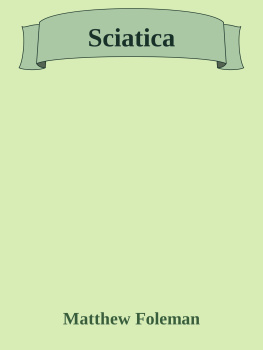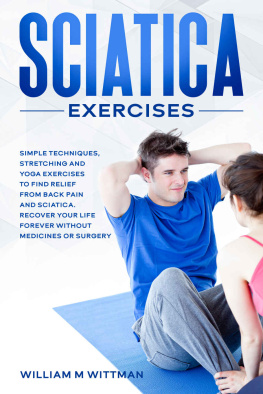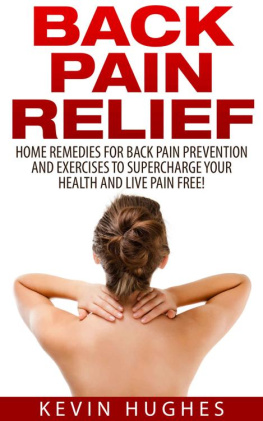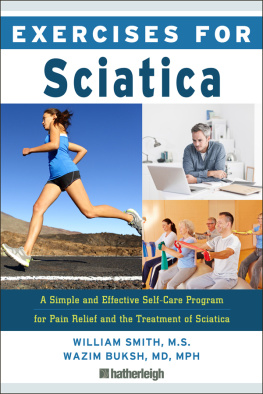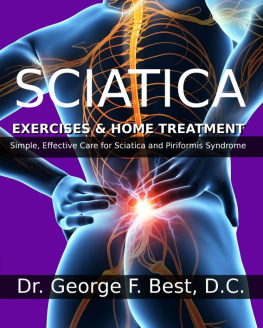Sciatica Pain Relief
32 Effective Solutions for Relieving Pain (Exercises, Nutrition, Preventative Measures, + More)
2nd Edition -
by Matthew Foleman
Table of Contents
Disclaimer
The information in this book is intended for informational purposes only and is not intended to be used as medical or professional advice. Always check with a doctor first before beginning any health program. A medical evaluation and clearance from a physician to participate in the activities that may or may not be presented in this book is recommended
No health claims are made for this book. The author shall have neither liability nor responsibility to any person or entity with respect to any of the information contained in these pages. The user assumes all risk for all injury, loss, or damage caused or alleged to be caused, directly or indirectly by using any information described in this book.
Copyright 2015 - All rights reserved.
This document is geared towards providing exact and reliable information in regards to the topic and issue covered. The publication is sold with the idea that the publisher is not required to render accounting, officially permitted, or otherwise, qualified services. If advice is necessary, legal or professional, a practiced individual in the profession should be ordered.
- From a Declaration of Principles which was accepted and approved equally by a Committee of the American Bar Association and a Committee of Publishers and Associations.
In no way is it legal to reproduce, duplicate, or transmit any part of this document in either electronic means or in printed format. Recording of this publication is strictly prohibited and any storage of this document is not allowed unless with written permission from the publisher. All rights reserved.
The information provided herein is stated to be truthful and consistent, in that any liability, in terms of inattention or otherwise, by any usage or abuse of any policies, processes, or directions contained within is the solitary and utter responsibility of the recipient reader. Under no circumstances will any legal responsibility or blame be held against the publisher for any reparation, damages, or monetary loss due to the information herein, either directly or indirectly.
Respective authors own all copyrights not held by the publisher.
The information herein is offered for informational purposes solely, and is universal as so. The presentation of the information is without contract or any type of guarantee assurance.
The trademarks that are used are without any consent, and the publication of the trademark is without permission or backing by the trademark owner. All trademarks and brands within this book are for clarifying purposes only and are the owned by the owners themselves, not affiliated with this document.
Introduction
Sciatica can affect anyone whether in good health or not. It can be sudden or it can gradually build until the pain is excruciating. Sciatica can be confused with lower back pain which the majority of people will suffer from at some point during their life. It is commonly thought that sciatica is an illness in itself but it is, in fact only a symptom of an underlying issue. This issue needs to be addressed before the sciatic pain will disappear. Unfortunately there are cases of the pain continuing after the underlying condition has been resolved.
Sciatica pain varies from person to person; it can cover the buttocks and the entire leg or be much more localized. Wherever it affects you it will cause problems with your movement and many positions will be very uncomfortable. Relief from the pain is usually available if you lie down but this is not of much help when attempting to continue with a normal daily routine.
There are a variety of theories on what causes sciatica. Many traditional medical professionals will list mechanical issues as the fundamental problem. This includes problems with the structure of the back or the pelvis. More modern medicinal approaches will often look at muscle knots and spasm and how they affect the sciatic nerve. Both approaches have merit and it can be difficult to pinpoint whether it is a muscular or mechanical issue unless further medical investigation is performed. For those that are suffering the real issue is pain relief to allow them to function normally again.
Being in pain, day after day often without any support or possibility of recovery will often result in depression. Sciatica will limit your favorite activities and can even make walking to the shop difficult or impossible. Living with long term sciatica and its affect on mobility can result in muscle wastage as you are unable to use your muscles correctly.
The good news is that there are ways of reducing or eliminating the pain and that a change to your diet and exercise routine can result in a pain free future. This book will be your guide and provide you with a variety of methods which should free you from pain and allow you to undertake your favorite activities again.
The book is divided into sections allowing you to understand what sciatica is, what causes it and who it affects. There are then thirty two methods for pain relief and a chapter on how to prevent the pain from returning.
Chapter 1 What is Sciatica?
The sciatic nerve runs from the spine down the back of each leg and stretches as far as our toes. It is the largest nerve in the body. At its starting point in the lower back it is actually several nerves which combine to form one big nerve. As it travels down the leg, pieces of it branch off to provide nerve responses in the thigh, the calf, the foot and even the toes.
If pressure is exerted on this nerve then it will cause a combination of pain, numbness and even a feeling of weakness. These symptoms will travel down the leg and can sometimes be felt in the foot. The exact area of pain will depend upon where the nerve is under pressure. The pain can range from a mild tingling to a deliberating agony where it becomes impossible to put any weight on the affected leg. Sciatica pain can be constant and sometimes it comes and goes; this is partially affected by the position of the body.
Although the sciatic nerve travels down both sides of the body it is rare to experience pain in both legs. The pain will always start in the buttock and will then continue down the leg becoming stronger in different areas of the leg. It is extremely rare for sciatica to cause any permanent nerve damage.
Sciatica is not actually a medical condition in itself; it is actually a symptom of another condition. This could be a herniated disc or a crushed disc. It may be due to an injury sustained in the area of the sciatic nerve or a wide range of other medical issues.
The condition can happen suddenly or it can gradually creep up on you and may initially only be noticed when you sneeze or cough. Sitting can often be painful as this increases the pressure on the spine and potentially the sciatic nerve.
When attending a clinic there are a variety of tests which they will perform to assess whether your pain is sciatica and at which point the nerve is being pinched. It is normal to be asked to lie on your back whilst the consultant raises one leg at a time. The point at which pain starts during a leg raise will provide an indication to the consultant as to where the pain originates from. This will provide a useful clue into whether one of your discs is damaged. Your consultant will need to review your medical history and will perform a physical examination; of course if the pain has happened suddenly it may be easier to pinpoint the source.
In extreme cases, particularly if has not been possible to make a diagnosis the consultant may believe it is necessary to commission an X-ray to look for any fractures in the spine. An MRI may also be used to check the structure of the back. If it is likely to be a disc or a vertebra then the consultant may arrange for dye to be injected between the vertebrae to confirm this.
Next page
